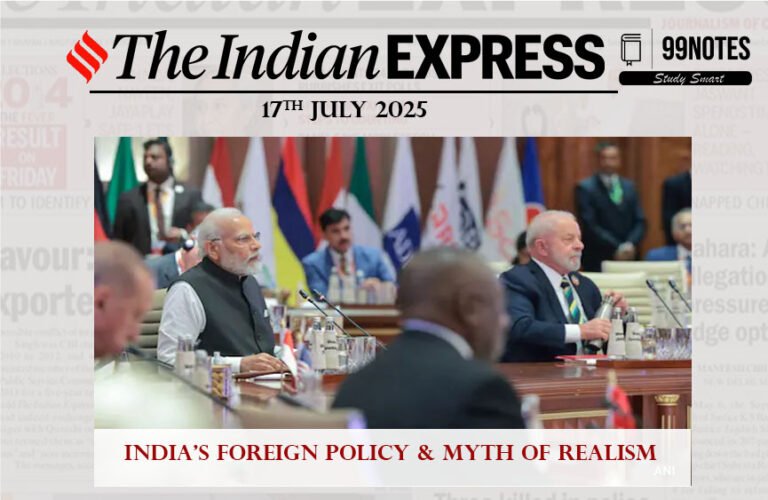25 August 2023 : Indian Express
Indian Express
- Indian Express
- 1. Growth & the Tier 2 City
- Context:
- What led to this problem of unemployment?
- Possible solutions to deal with the problem of unemployment.
- Problems in the education sector:
- What can India do to scale up investments in human infrastructure, particularly education?
- Reversal of Trend:
- Potential of Tier-2 cities:
- Way Forward:
- For Enquiry
25-August–2023
The Indian Express, CSE candidates can stay informed about current events and developments in India and around the world.
1. Growth & the Tier 2 City
Context:
- As the fastest-growing large economy in the world, India’s high growth has attracted headlines. But, with nearly a quarter of the youth being unemployed, India’s youth unemployment has also attracted attention.
- More than 50 percent of India’s population is below the age of 25 and more than 65 percent is below the age of 35. The coexistence of high economic growth and high unemployment is a puzzle.
What led to this problem of unemployment?
- For a young country like India, high growth and unemployment is not a paradox or a reflection of automation or artificial intelligence, but lop-sided development policies that have resulted in fewer jobs being created for millions who join the labour force every year.
- India has the largest concentration of illiterate people in the world. More than one third of India’s adult population remains illiterate, and less than 20 percent have completed secondary education.
- There are well-understood limits to the pace with which India can accumulate physical infrastructure. But there are no limits to the pace at which India can accelerate human capital.
- India’s infrastructure investments, which are largely focused on the urban areas, have resulted in lopsided spatial development that has slowed the pace of job creation.
- India’s manufacturing sector is rapidly de urbanising and moving from urban to rural areas to remain competitive. However, the manufacturing sector is not able to grow fast, as rural areas lack adequate physical and human infrastructure.
Possible solutions to deal with the problem of unemployment.
- India needs good infrastructure, both physical and human, to create more jobs.
- The country has made huge progress in improving its physical infrastructure but has fallen behind on human infrastructure like education and skills. Physical infrastructure in the absence of good human infrastructure has slowed the pace of job growth.
- Physical infrastructure investments are also focused on urban areas, but the manufacturing sector is migrating away from urban to rural areas to remain cost-competitive. However, poor physical and human infrastructure in rural areas has constrained the growth drivers and limited the size of the manufacturing sector in India. This needs to be looked into.
- Returns to investment in education are much higher than the returns to investment in physical investment.
Problems in the education sector:
- The challenges are enormous in rural areas. They are also multidimensional —access, quality, relevance, finance and governance.
- Despite a few excellent public and private universities in India, concerns have been raised about the quality of education due to a huge variation in the quality of graduates from both the public and private systems.
- Effective systems of quality assurance do not exist, either for the public or the private sector.
- Compounding this problem is a shortage of qualified faculty due to poor compensation, rigidities in the number of places allocated to different disciplines in the public system, outdated curricula and pedagogical methods that still rely too much on rote learning rather than creative thinking and problem-solving and teamwork that is needed by the market.
What can India do to scale up investments in human infrastructure, particularly education?
- As the education system becomes more complex with multiple players and multiple pathways, the governance of the education system needs to be improved, and new and better systems must be established.
- It needs better incentives, monitoring, performance assessment, and accountability both for the internal processes of the education process as well as for students.
- A key challenge is to scale up tertiary education. This will increase the cadres of professionals who can create new enterprises and maximize job creation.
- Tertiary education increases the dissemination of knowledge beyond universities, through interactions between firms and the rest of society.
- Policymakers need to recognise that investments in education will accelerate the pace of job creation.
- Most of the jobs are created by new enterprises, and enterprises, both domestic and foreign, look for both skilled workers and a good physical infrastructure. Given India’s large youth bulge, the potential to benefit from education is huge.
- Education and skills are becoming more important as new enterprises make their location decisions based on the education and skills of the local workforce.
Reversal of Trend:
- In the early 1990s, India’s manufacturing sector walked hand in hand with urbanisation. This process has reversed from 2000 onwards, with the pace of de-urbanisation of manufacturing gathering momentum.
- Industrial firms are choosing to locate in rural areas due to a combination of cheaper land prices, lower pollution restrictions, weaker congestion and other spatial factors.
- India’s urbanisation and industrialisation paths have diverged. India’s pre-mature de-industrialisation, or the secular slow-down in the manufacturing trend, is due to the divergence in the paths of urbanisation and industrialization.
Potential of Tier-2 cities:
- The future of economic growth will not be in tier I cities, which are already dense with India’s best and brightest, but in tier II cities.
- New cities have the potential to generate 70 percent of the country’s new jobs and GDP over the next 20 years, a process that could drive a four-fold increase in per capita incomes.
- For eg: In China and the USA, intermediate cities have become the new drivers of growth and job creation.
- Globally, manufacturing has been dispersing from high-density clusters to less dense areas.
Way Forward:
- The divergence in the paths of urbanisation and industrialisation raises big policy questions for policymakers.
- India needs a broader focus on rural structural transformation to accelerate job creation.
- This can be achieved if policy makers can scale up physical and human infrastructure investments to build the missing links between urban and rural India.
- The de-urbanisation of the manufacturing sector has scaled up the importance of rural development and job creation agenda.
For Enquiry

25 August 2023 : Indian Express

25 August 2023 : PIB

25 August 2023 : The Hindu Editorial Notes PDF

25 August 2023 : Daily Current Affairs

24 August 2023 : Daily Answer Writing

23 August 2023 : Daily Answer Writing

24 August 2023 : Daily Quiz

23 August 2023 : Daily Quiz

24 August 2023 : Indian Express

23 August 2023 : Indian Express
August 2023 Indian Express 25 August 2023 : Indian Express Indian Express
24-August–2023
The Indian Express, CSE candidates can stay informed about current…
August PIB 2023 25 August 2023 : PIB PRESS INFORMATION BUREAU
25-August -2023
Daily Current Affairs For UPSC ,The PIB ( Press Information…
August- The Hindu Editorial 25 August 2023 : The Hindu Editorial Notes PDF The Hindu Editorial
25-August-2023
Daily Current Affairs For UPSC ,The Hindu Editorial Summary
Facebook-f
Twitter
Youtube
1….
August Daily Current Affairs 25 August 2023 : Daily Current Affairs Daily Current Affairs
25-August-2023
Daily Current Affairs For UPSC ,Daily Current affairs of The hIndu…
mains answer writing 24 August 2023 : Daily Answer Writing Mains Answer Writing
One of the key components of these exams is the written test, which consists of…
mains answer writing 23 August 2023 : Daily Answer Writing Mains Answer Writing
One of the key components of these exams is the written test, which consists of…
Daily Quiz 24 August 2023 : Daily Quiz 24 August 2023 : Daily Quiz…
Daily Quiz 23 August 2023 : Daily Quiz 23 August 2023 : Daily Quiz…
August 2023 Indian Express 24 August 2023 : Indian Express Indian Express
24-August–2023
The Indian Express, CSE candidates can stay informed about current…
August 2023 Indian Express 23 August 2023 : Indian Express Indian Express
23-August–2023
The Indian Express, CSE candidates can stay informed about current…




